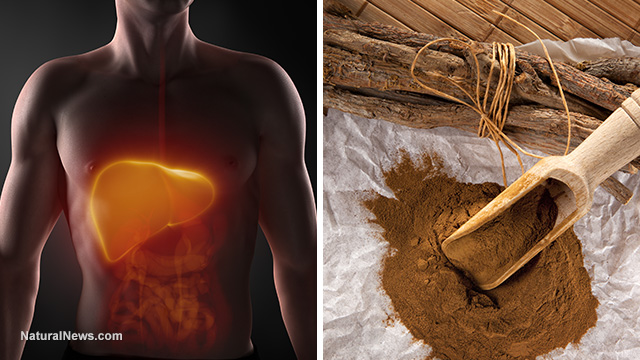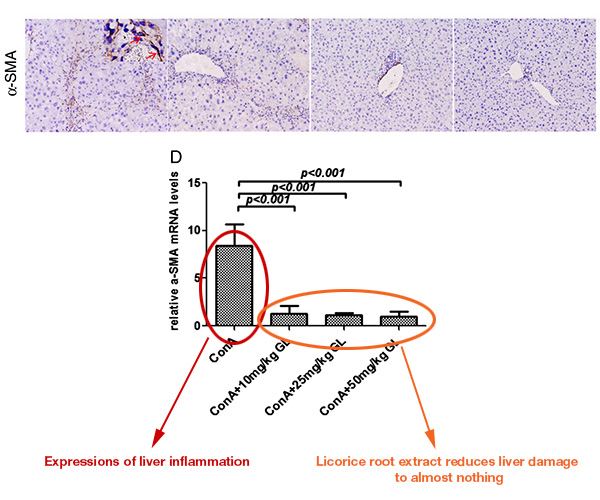Constipation Cure
Solve the root cause of constipation. Full herbal program.
Epsom Salt Capsules
Hulda Clark Liver Cleanse
End Constipation Now
Let oxygen remove old, impacted fecal matter as it detoxifies and...
Constipation Cure
Solve the root cause of constipation. Full herbal program.
Epsom Salt Capsules
Hulda Clark Liver Cleanse
End Constipation Now
Let oxygen remove old, impacted fecal matter as it detoxifies and...
Miracle molecule from licorice root nullifies liver damage from alcohol and Tylenol... stunning scientific research has been systematically suppressed by Big Pharma and the FDA

(NaturalNews) In what is undoubtedly one of the most astonishing herbal cures story of the decade, a natural molecule from licorice root extract -- "glycyrrhizin" -- has been repeatedly and scientifically shown to block nearly all liver damage from both alcohol consumption and over-the-counter Tylenol pills (acetaminophen).
Here I've collected PDFs of seven scientific studies that show astonishing "hepatoprotective" effects (meaning it protects the liver) from the cellular damage caused by alcohol and Tylenol. It also happens to exhibit strong anti-viral, anti-tumor and anti-inflammation effects at the same time.
This may be the closest thing to a "miracle cure" for liver disease, cirrhosis and liver cancer that's ever been discovered. Yet nobody in the pharmaceutical industry has ever mentioned it. The media won't cover it, and the FDA has criminalized any real discussion of this by licorice root manufacturers or supplement companies.
U.S. government blocking the public from learning about this "miracle molecule" for liver health
The U.S. federal government has gone out of its way to block the public from learning this information, even banning a licorice root extract company called "NTX Technology" from being able to put accurate label claims on alcohol products infused with their herb-derived compound called "NTX."
The innovative molecule is "Scientific, preventative and recreational all at the same time—while protecting the liver," NTX Technology founder Chigurupati told the Tasting Panel Magazine last year. Human study trial results showed that NTX massively reduced harmful effects on the liver by up to 93 percent. (See NTX molecule scientifically shown to protect liver from alcohol poisoning being censored by Obama's Tax and Trade Bureau.
See the company's website at NTXtechnology.com.
Glycyrrhizin from licorice root a powerful, potent liver protector with anti-viral, anti-tumor, anti-inflammation properties
Now, I've compiled some of the highlights of the astonishing research on glycyrrhizin and its related glycyrrhetinic acid (GA) on protecting the liver from alcohol damage and Tylenol damage. Links to each study are provided below.
NOTE: In the science studies below, GL and GA both refer to compounds of glycyrrhizin from licorice root.
The effects of pretreatment with glycyrrhizin and glycyrrhetinic acid on the retrorsine-induced hepatotoxicity in rats
"The results demonstrated that a three-day pretreatment with either GL or GA exhibited protective effect on retrorsine-induced liver damage in rats."
Recent advances in natural products from plants for treatment of liver diseases
"Glycyrrhizin (Fig. 3), a major biological active constituent of licorice (Glycyrrhiza glabra) root, has various pharmacological effects and been used as a treatment for chronic hepatitis.
It is a natural anti-inflammatory and antiviral triterpene and is ancillary drugs used clinically in China for protection of liver function and treatment of tumors. Glycyrrhizin had a protective effect on immunosuppression, a strong non-specific anti-inflammatory effect, and an effect of reducing the incidence of sodium and water retention[29]. These results suggest that glycyrrhizin alleviates CCl4-induced liver injury, and this protection is likely due to the induction of heme oxygenase-1 and the downregulation of pro-inflammatory mediators and may represent a potent drug protecting the liver injury."
Check out this chart from the study, showing how glycyrrhizin drastically reduces expressions of liver inflammation and damage to near zero:
Glycyrrhizic acid modulates t-BHP induced apoptosis in primary rat hepatocytes
"The protective potential against cell death was achieved mainly by preventing intracellular GSH depletion, decrease in ROS formation as well as inhibition of mitochondrial membrane depolarization. [Glycyrrhizic acid] was found to modulate critical end points of oxidative stress induced apoptosis and could be beneficial against liver diseases where oxidative stress is known to play a crucial role."
Glycyrrhizin regulates CD4+T cell response during liver fibrogenesis via JNK, ERK and PI3K/AKT pathway
"Notably, GL not only inhibited ConA-induced proliferation of splenic CD4+T cells but also enhanced the mRNAs of IFN-y and IL-10 in these cells... Moreover, GL significantly inhibited ConA-induced phosphorylation of JNK, ERK and PI3K/AKT in vitro. Collectively, GL might alleviate liver injury and fibrosis progression via regulation of CD4+T cell response in JNK, ERK and PI3K/AKT-dependent pathways.
Liver cirrhosis, the common clinical endpoint of chronic liver diseases, is characterized by tissue fibrosis, replacement of normal liver architecture by structurally abnormal nodules and the development of portal hypertension and other life-threatening complications [1–3]. Inhibition of fibrogenesis at an early stage is nowadays considered as a feasible strategy to treat liver cirrhosis [2,4].
In this study, using ConA-induced mouse liver fibrosis models, we found that glycyrrhizin (GL) significantly attenuated fibrosis progression. GL not only reduced liver inflammation, but significantly suppressed the activation of HSCs and reduced collagen accumulation in mice (Fig. 1).
These changes were accompanied by the down-regulation of CD4+T cells infiltration in the livers and spleens of mice with hepatic fibrosis (Figs. 2 and 3). GL is a natural anti-inflammatory and antiviral triterpene to treat patients with viral hepatitis (hepatitis B and hepatitis C) and to reduce the risk of hepatocellular carcinoma after hepatitis-C virus (HCV) infection in China and Japan [22–27,32]. GL could also inhibit the cytotoxicity mediated by CD4+T cells and TNF [33]. GL has a membrane stabilizing effect [34] and also stimulates endogenous production of interferon [21,25,26]. 18-(Beta) GL shows an antiviral activity against a great deal of DNA and RNA viruses due to potential activation of NF-kB and induction of IL-8 secretion [35]. 18-(alpha) GL is also reported to suppress the activation of HSCs and induce the apoptosis of HSCs by blocking the translocation of NF-kB to the nucleus [36]."
Radical scavenging ability of glycyrrhizin
"Glycyrrhizin (Gly), a major constituent of licorice root, has been used for the treatment of chronic liver diseases in Japan... The scavenging abilities of Gly and GA might play a role in the treatment of chronic liver diseases. Glycyrrhizin (Gly), a major constituent of licorice root, is known to have anti-inflammatory,1,2 antiallergic,3e6 and antiviral7,8 activities, and has been used for the treatment of chronic liver diseases by intravenous or oral administration in Japan. Many reports about the biological action of Gly and its mechanisms have been published. 9e11 Gly acts as a radical scavenger in biological systems, such as ischemiaereperfusion injury,12,13 macrophage-like cells,14 and gastric epithelial cells.15"
Pregnane X receptor mediated-transcription regulation of CYP3A by glycyrrhizin: A possible mechanism for its hepatoprotective property against lithocholic acid-induced injury
"Licorice (LE) has been commonly used in traditional Chinese medicine (TCM) for over 4000 years to reconcile various drugs and for hepatic disorders. Glycyrrhizin is the main bioactive component isolated from LE herbs. In the present study we examined the effects of glycyrrhizin on pregnane X receptor (PXR)-mediated CYP3A expression and its hepatoprotective activity.
Glycyrrhizin regulates the expression of the gene mentioned above to prevent toxic accumulation of bile acids in the liver and it also protects mouse livers from the harmful effects of LCA. In conclusion, PXR-mediated effects on CYP3A and CYP7A may contribute to the hepatoprotective property of glycyrrhizin against LCA-induced liver injury."
Hepatoprotective and anti-hepatocarcinogenic effects of glycyrrhizin and matrine
"Matrine (Mat), a component extracted from Sophora flavescens Ait, has a wide spectrum of pharmacological effects. Glycyrrhizin (Gly), a major active constituent of licorice (Glycyrrhiza glabra) root, has various pharmacological effects.
The results showed that compared with Gly or Mat alone, Gly + Mat reduced the mortality of acetaminophen overdosed mice more effectively, attenuate acetaminophen-induced hepatotoxicity, and reduced the number and area of GT positive foci, thus protecting liver function and preventing HCC from occurring. In addition, Gly + Mat had a protective effect on immunosuppression, a strong non-specific anti-inflammatory effect, and an effect of reducing the incidence of sodium and water retention.
Glycyrrhizin (Gly) (molecular formula: C42H62O16), a triterpene glycoside and a conjugative compound of enoxolone and glucuronic acid as an active component of licorice (Glycyrrhiza glabra) root, has a variety of pharmacological actions including anti-inflammatory, anti-viral, antioxidative, anti-liver cancer, immunomodulatory, hepatoprotective and cardioprotective activities [11–15]. It has been used for more than 20 years in the treatment and prevention of hepatitis, chronic bronchitis, gastritis, tumor growth and immunological disorders."
Click here for my new podcast on all this research or play any of the podcasts below:
Learn more: http://www.naturalnews.com/052877_glycyrrhizin_licorice_root_extract_liver_protection.html#ixzz3zMNJSyov
This Forum message belongs to a larger discussion thread. See the complete thread below. You can reply to this message!
-
Expand this whole thread (2 messages)
Miracle molecule from licorice root nullifies live... InCharge
8 y
2,282
† C †
InCharge
8 y
2,282
† C †
This is the position of the above message within the thread.
CureZone Newsletter is distributed in partnership with https://www.netatlantic.com
Contact Us - Advertise - Stats
0.109 sec, (7)

